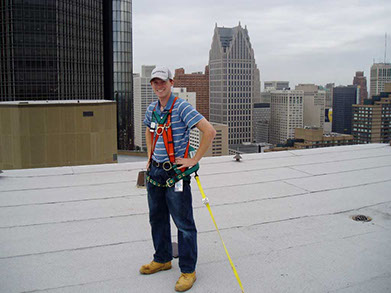< BACK TO STRUCTURETEC BLOG
Eliminate Fall Hazards and Make Your Building a Safer Place to Work
April 6, 2016
Falls are among the most common causes of serious work related injuries and deaths. In 2014, fall protection was the number one violation on Occupational Health and Safety Regulation’s (OSHA) top 10 most-cited violations, a position it has held for 4 consecutive years.
It is an employer’s responsibility to set up the work place to prevent workers from falling off overhead platforms, elevated work stations and roof and wall structures. When workers are at risk of falling, the employer must have a written fall protection plan in place and available at the workplace before any work with the risk of falling can begin.
These guidelines and regulations are mandatory under OHSA and American National Standards Institute (ANSI) works to ensure consistency of these standards. Once you have developed a written safety plan, you must then provide the required fall protection systems and adequately train employees and visitors prior to engaging in any at risk activity.
Fall protection systems can be divided into three types:
- Fall Prevention
- Fall Restraint
- Fall Arrest
A Fall Prevention System/Plan is designed to prevent or eliminate the risk of falls through proper planning including restriction of access, safe access zones and signage. Fall Restraint Systems are designed to allow a worker to get near an edge without actually going over the edge. A Fall Arrest System is defined as a system that protects a worker after a fall by stopping them from hitting the surface below.
Incorporating Fall Protection Systems in the Workplace
Your primary focus should always be eliminating fall hazards by preventing through proper fall prevention techniques. When that’s not possible, you need to provide Fall Restraint and Arrest systems to ensure workplace safety, some common examples of such systems are:
1. Guardrails
Guardrails are the most common fall protection system used to protect workers at openings and on platforms. Guardrails must be continuous, with no portion of the leading edge exposed, and meet the strength requirements.
- Guardrails should be removed only when materials are being on-loaded or off-loaded. Once the materials have been positioned, replace the guardrails immediately.
- Ensure that each top rail, or equivalent member of a guardrail system, can withstand a force of at least 200 pounds. Top rails must be between 39 and 45 inches.
- Make sure that midrails, screens, mesh, intermediate vertical members or panels can withstand a force of at least 150 pounds.
2. Hole Covers
Any opening that measures at least two inches or more in its least dimension in a floor, roof or walking surface must be covered. Covers should be able to support at least two times the weight that will cross over them.
3. Personal Fall Restraint Systems
This system can be a full body harness or a body belt that’s rigged to physically restrict the worker from reaching an area where a free fall could occur. It’s designed to hold the worker back, but not provide support in a fall. These systems are commonly used on leading edge work such as roofs, open-sided floors and work platforms.
4. Safety Net Systems
Safety nets, which catch the worker after a fall, are often found under bridgework, steel erection, demolition and maintenance operations. They should be installed as close as possible under the walking/working surface, but never allow a fall of more than 30 feet.
5. Personal Fall Arrest Systems (PFAS)
A PFAS keeps the worker from hitting the ground or other obstructions below. The PFAS, consisting of a body harness, connecting device and anchorage, must prevent the worker from free falling more than six feet. The arresting force on the worker must be limited to 1,800 pounds or less, and the anchorage point must be capable of supporting 5,000 pounds per person attached. When vertical lifelines are used, each worker must be attached to a separate lifeline.
Anchorage Points
It is important to remember that a personal fall restraint or arrest system is only as good as its anchor point. It doesn’t matter how well trained personnel are, how good the equipment is, or whether or not the employee is tied off correctly. If the anchor point fails, nothing in the system will work.
Accidents often happen when the risks seem minimal, but are not. When a fall occurs, there will be no dramatic life-saving catch by a fellow co-worker like you see in the movies. Proper use of safety equipment and fall protection helps to ensure that no matter how comfortable your workers are, should a fall occur, they will be protected. It is crucial to educate and train workers to properly use fall protection and to always remember to wear personal protective equipment, because nobody can defy the laws of gravity.
Please contact StructureTec to learn more about Fall Protection Systems and always remember to check with OSHA and other governing bodies to ensure fall protection compliance.
WHAT WE DO
StructureTec is a building envelope, pavement, and roof consultant specializing in the waterproofing and restoration of existing building envelopes, roofs, pavement and concrete structures.
"We provide the best solutions"



